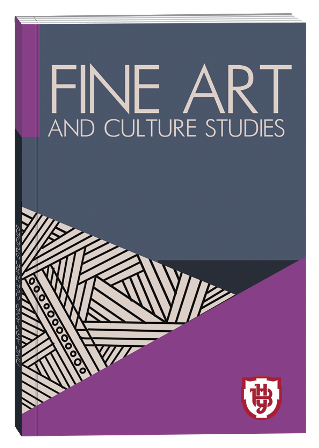REPERTOIRE POLICY OF THE OPERA HOUSE OF LA MONNAIE IN THE CONTEXT OF CURRENT EUROPEAN TRENDS
DOI:
https://doi.org/10.32782/facs-2023-2-6Keywords:
La Monnaie National Opera House, repertoire, synthesis of arts, director's theatre, conductor's оpera, interpretative thinking, singer-artist, stage time-space.Abstract
Resolving the contradictions surrounding any modern musical theatre is an urgent need for musicology. The history and activities of the National Opera House of Belgium, La Monnaie, are relatively little known in Ukraine. The repertoire policy of the creative team reflects the general trends in the interpretation of European opera in the postmodern era. The urgency of the topic is stipulated by the lack of information about the famous theatre in the national opera science. The purpose of the article is to highlight the principles of the repertoire policy of the leading opera house La Monnaie in the aspect of the performing vision of this problem using the example of two operas (“Tannhäuser” by R. Wagner and “Aida” by G. Verdi). Research methods are determined by the specifics of the selected material: historicalgenre – reveals the evolution of European opera and its stylistic dynamics through the laws of musical drama; individualstylistic – provides awareness of the composer's thinking principles; interpretative – attests to the interpretation of an opera composition by directors, conductors, and performers who fight for their own vision of its modern existence. In the light of scientific discussions about opera and its modern transformations, there are two trends – regie-theatre and “conductor's opera”, which demonstrate the idea of an immortal genre of new European culture in the context of postmodern culture. The content of repertoire policy as a problem is revealed through two types of creative leadership – a conductor or a director. And although the expression “creative tandem” is often used, in fact, these are different approaches to the existence of opera in modern conditions and an understanding of what, in fact, the modern audience needs. Who will capture the soul or mind of the viewer “live”? If it is a spectacular-visual series that tries to “modernize” the sound of music through the “weaving” of the stage space-time, then this is a victory for the director. He/she considers his/ her mission more important because he/she is responsible for the commercial success of the project. (An example is the performance of R. Wagner's ”Tannhäuser” opera in 2004, conducted by the brilliant Japanese conductor Kazushi Ono and directed by Jan Fabre). Regie-theatre is opposed by the “conductor's opera”: G. Verdi's “Aida” of 2017 (director – Robert Wilson; conductor – Alen Altinoglu) is chosen as an example. From the point of view of the performer-singer, the director's way of re-interpreting opera classics is becoming tiring, no longer justifies itself, the time of its dominance is passing. Obeying the director's idea while working on the realization of the music is a great responsibility, but there is no satisfaction: you often do not understand the idea, because you do not see the overall “picture”. Of course, at rehearsals, the singer-artist must be a flexible and expressive representative of the director's ideas. However, the performance as a whole body has a primary source – the composer's score, which is a criterion for matching the work's past and its modernity. And here the singer's ear and heart work as a barometer for the weather outside the walls of the theatre. Falsity, excessive intellectualism, stupid taste – the public rejects it like a child rejects a bad toy! Conclusions. According to the singers-artists, the duel for supremacy in the viable concept of opera between the director and the conductor takes place in favour of the conductor! If the director's interpretative thinking concerns the external form of the “reincarnation” of the opera composition, then the conductor's approach is the experience of preserving the internal form of the composition. The director is “obsessed” as a rule, on non-musical effects; the world of his/her “fantasies” aims to surprise the listeners with a visual sequence parallel to the music and preferably with “cognitive dissonance”, as if to make them think, to surprise them. Certain socio-cultural, national-mental influences (motives) take place here. Critics are not always able to justify the individual personality of the director, who may not be knowledgeable in musical creativity, but conquers with the magic of charisma! The conductor's interpretative thinking is a more natural way of communication for the vocalist: it is more harmoniously "superimposed" on the stage time-space. If the conductor breathes, as if singing, takes into account all other components of the opera text (tempo, plasticity of movement, psychological mood), then vocals are above all! This was the case at the beginning of the 20th century when the conductor's profession became clear and he/she took the place at the console like a theurgist! And so it should be in the 21st century after the challenges and frustrations of the director's dictate. The cited quotes from music critics add an objective basis to the author's subjective reasoning.
References
Єфіменко А.Г. Режисерська інтерпретація оперної класики ХХ століття: Моріс Равель і Олександр Цемлінський на сцені Баварської державної опери. Часопис Національної музичної академії України імені П.І.Чайковського. Науковий журнал. №3 (16), 2012. С. 84–89.
Мельник Л. Народження скандалу з духу критики: Regie-театр та його віддзеркалення. Науковий вісник Національної музичної академії України імені П. Чайковського. Вип. 89 : Сучасний оперний театр і проблеми оперознавства : зб. ст. / ред.-упор. М. Р.Черкашина-Губаренко. Київ, 2010. С. 206–215.
Нестьєва М. Режисер і композитор – однодумці чи супротивники? Часопис Національної музичної академії України імені П.І.Чайковського. Науковий журнал. №3 (16), 2012. С. 11–18.
Черкашина М. Оперний Берлін через двадцять років. Часопис Національної музичної академії України імені П.І.Чайковського. Науковий журнал. №3 (16), 2012. С. 17–22.
Blanmont, Nicolas (2004). Tannhäuser: Fabre, mais aussi Ono. URL: https://www.lalibre.be/culture/ musique/2004/06/08/tannhauser-fabre-mais-aussi-ono-P6N6OEMCI5BDBMV7WMEBT3XUO4/
Dumont-Mergeay, Martine (2002). Aïda ou le triomphe de Robert. URL: https://www.lalibre.be/culture/ musique/2002/01/31/aida-ou-le-triomphe-de-robert-7MC7ENRYMVFBZO2ALIZHAOU4GA/
Jottrand, Claude (2017). Le drame intime au coeur de la vision de Livathinos. URL: https://www.forumopera.com/ aida-bruxelles-la-monnaie-le-drame-intime-au-coeur-de-la-vision-de-livathinos
Peeters, Bruno (2017). Aïda : un opéra de chef ? URL: https://www.crescendo-magazine.be/aida-un-opera-de-chef/







